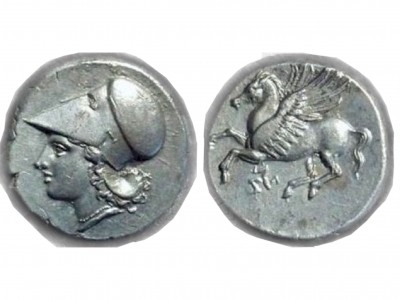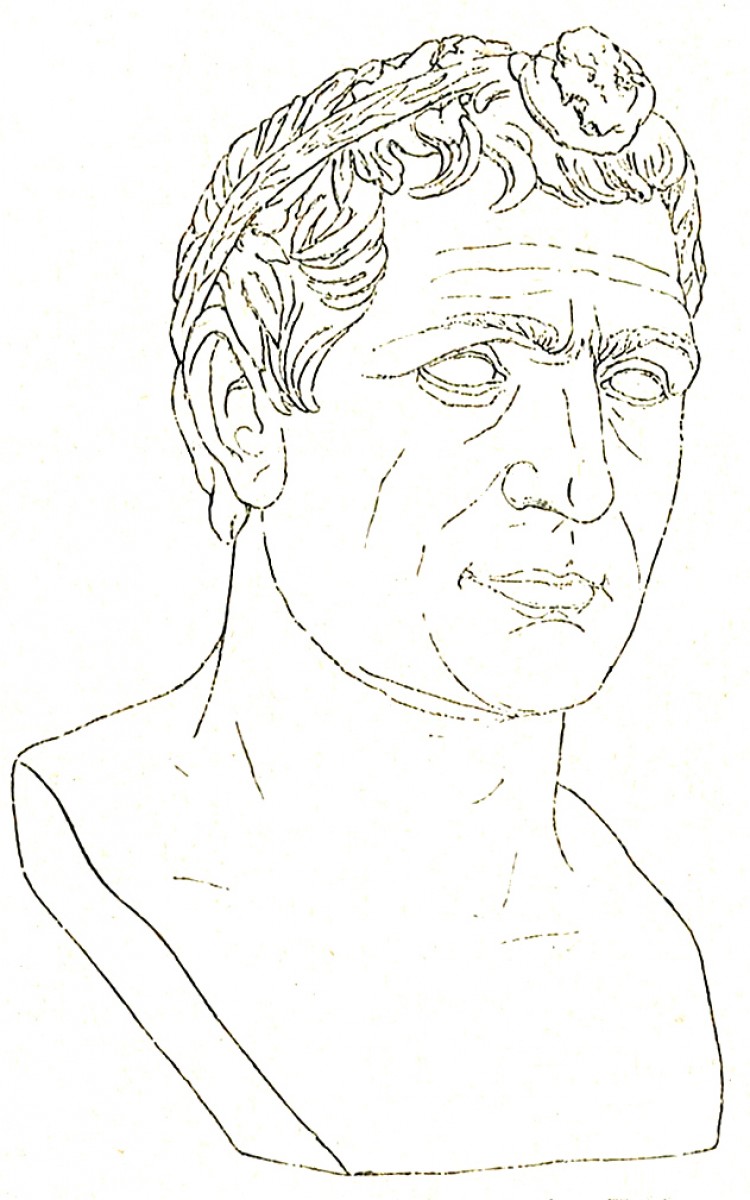Syracusan tyrant Agathocles (Agathocles) (361-289 BC)
Agathocles was born in the Sicilian city of Himera ([i:aaaa]Roman name Thermae Himeraeae, now Termini Imerese) on the northern coast of the island ([i:aaaa]southeast of Panormo, today's Palermo). His father, a potter, moved with his young son to Syracuse about 343 BC, where Agathocles, although apprenticed to the potter's trade by his father, joined the army.
In 333 BC he married the widow of a wealthy burgher. Sicily at that time was ruled by the oligarchic government of the Six Hundred, which had replaced democracy under the constitution of Timoleon. This government sent a Syracusan army to aid the Crotonians in their struggle with the Brutii (southern Italian Hellenic cities). Agathocles showed bravery in the fighting and was not happy that he was not properly appreciated. At the head of his forces, he twice attempted to seize control of Syracuse.
For preparing to overthrow the oligarchic government of Syracuse he was twice sent into exile, once escaping the assassins sent by disguising himself as a beggar. From the second exile - supported by the Carthaginians - he returned in 317 BC at the head of a mercenary army under oath to oversee the implementation of a democratic constitution in the city. Agathocles proved himself a born leader of the mercenary army. The Mamertines, mercenaries he hired in Campania, played a significant role in Sicily after his death (see First Punic War).
When Agathocles entered the city, his soldiers killed 40 senators and 4,000 other citizens, and 6,000 Syracusans fled or were sent into exile. Agathocles then had an assembly convened and told them that he would take over the leadership of the city only if dictatorial powers were voted to him. Naturally, he got them. The promised democracy ended "by the will of the people".
Agathokles promised debt forgiveness and land reform. He built up a strong army and navy, and within three years (316-313 BC) had conquered much of Sicily (the eastern half), including the strategically located Messana. Inevitably, a clash with the power that controlled the western coast of Sicily, Carthage, ensued.
The brief intermezzo between the campaign for control of the Hellenic cities in Sicily and the war with Carthage was an attempt by the exiled Syracusans, who in their exile in Sparta persuaded the local king Claomenes to send his son Acrotatus to Sicily. However, when Agathocles had the exiled leader Sosistratus killed at a party, Acrotatus quickly disappeared from Sicily.
Meanwhile, the Carthaginians sent an army to Sicily, and its commander Hamilcar made an agreement with Agathocles to divide the spheres of influence, with the Hellenic cities retaining their autonomy. Agathocles, however, seems to have conceived of autonomy as something quite different from that of these cities and the Carthaginians. When he had 600 prominent inhabitants of Messana and Taormina, who did not share his idea, murdered and besieged Acreganto (today's Agrigento on the southern coast of Sicily), the Carthaginians (to whom the Syracusan exiles were now hopefully also attached) intervened militarily against him.
The military might of Carthage was no match for that of Syracuse. The war began with the capture of twenty Syracusan warships, and Agathocles' only "military success" was the subsequent slaughter of 4,000 inhabitants of Gela. In 311 BC, Agathocles was defeated at the Battle of the River Himera (near his hometown), where he lost 7,000 men who succumbed to both the Carthaginian cavalry and thirst quenched by salt water. A siege of Syracuse itself followed.
In 310 BC Agathocles decided to break the naval blockade and attack the Carthaginians in Africa. He began successfully - using the wealth stolen from the sixteen hundred slaughtered wealthiest inhabitants of Syracuse and the temples to finance an expedition of 60 ships full of soldiers across the Mediterranean. As a sacrifice to the goddess Demeter and Persephone, he burned his ships (and with them a retreat route) and conquered Tunés (modern Tunis), where he fortified himself.
The Carthaginians retreated to Carthage after their defeat. They believed that their failure was due to the fact that they had cheated their gods regarding child sacrifices, and so they supposedly sacrificed 500 children. These horrific practices (if true) did not help. Agathocles' brother, Antander, managed to defeat, capture, and kill Hamilcar in Sicily, freeing the besieged Syracuse. Acreganto was rid of the Syracusan garrison and gained independence.
Meanwhile, a revolt broke out in Tunis against Agathocles in the ranks of his army. His demonstrative suicide, however, induced the soldiers to reinstate him at their head. Agathocles made a treaty of alliance with Ophello, the Egyptian governor of Cyrenaica, and when the latter arrived with his army, he killed him and took command of it.
He then invaded Utica, using 300 of their most prominent citizens, whom he held hostage, as shields for his siege engines. He achieved several more partial victories, but still failed to achieve a decisive victory. In Sicily, meanwhile, his generals had defeated the rebellious Acregians, but one of Agathocles' old friends, Deinocrates, subsequently led their resistance and raised an army of twenty thousand, threatening Agathocles' dominion over the Syracusan states.
In 307 BC, Aghathokles was defeated head on in Africa. He retreated back to Tenes, from where (on his second attempt) he secretly fled to Sicily. Two-thirds of his army in Africa, led by his son, was destroyed, his sons killed, the commanders who refused to surrender crucified, and their soldiers sold into slavery.
The following year, his army conquered and sacked Carthage's Egesta (Segesta), and Agathocles made peace with Carthage on relatively favourable terms - Carthage's dominion remained limited to the territory west of the Halycus River (today's Platani), which was no more than before the war. This allowed him to deal with Deinocrates.
By 304 BC, Syracuse was again the undisputed ruler, and he declared himself king of Syracuse, consolidating his rule over the Greek cities on the island, which had been assigned to him by the treaty with Carthage. Agathocles married a second time to Theoxena, the stepdaughter of the Egyptian king Ptolemy I, with whom he had made an alliance, and married his daughter Lanassa to King Pyrrhus of Epirus. He thus placed himself in the structure of the rulers of the former Alexander's empire.
He then led several military campaigns into southern Italy and, in addition, in 298 BC he conquered the island of Corcyra (modern Kerkyra off the western coast of Greece) in Macedonia, which was at war with his ally Ptolemy of Egypt. Finally, he still had 2,000 Southern Italian Ligurians and Etruscans slaughtered who refused to pay the fees he demanded after his military incursion into Italy.
Agathocles died in 289 BC. He may have been poisoned at the behest of his son Archagathus, but more likely he died of natural causes - his health was failing towards the end of his life; his relations with his son were not rosy either. Nevertheless, he was very vital until his death, and is said to have been planning another war with Carthage.
Some sources state that Agathocles was one of Syracuse's mild and popular tyrants ([i:aaaa]the term tyrant did not originally have the pejorative meaning it has today, it simply denotes a recluse), but the above list of his drastic measures makes me question where they get this information from.
On his deathbed, he set back Syracusan democracy because he didn't want his sons to rule after him. After his death, there was a civil war in Syracuse in which an attempt by Agathocles' grandson or son (perhaps both) to seize control of the city was averted.
Stříbrná litra ražená Agatoklem, tehdejším tyranem v Syrakusách, zobrazující vpravo hlavu Athény a na rubu Pegase, který má pod břichem trojlístek odkazující na Agatokla.
commons.wikimedia.org

